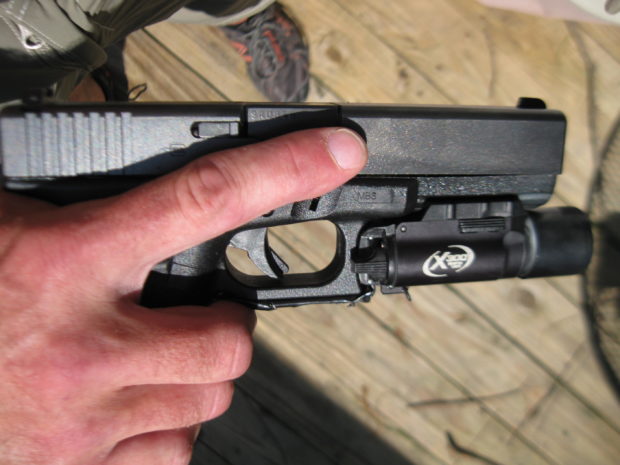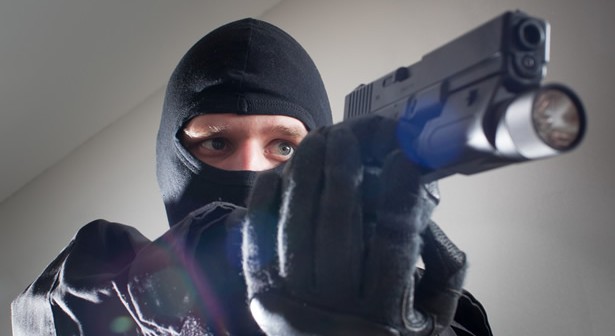Written by: Greg Ellifritz
Recently, there has been some high level media “reporting” about the so called “dangers” of weapon mounted lights (WMLs). It seems that much of the interest about the story was prompted by the Denver Colorado police department banning the use of WMLs by its police officers. Check out the links below for more details:
Gun-mounted flashlights linked to deadly accidental police shootings
Weapon Lights: Serious Problem or Bad Reporting?
Here’s the reality. It’s easier to blame a series of negligent shootings on an “unsafe product” than it is to revamp woefully inadequate police training programs.
WMLs have been somewhat controversial in the last few years. In issue 173 of the Force Science Newsletter, the well-respected Force Science Research group recommended against officers using weapons mounted lights (specifically the SureFire light with DG switch). Check your old emails for that issue, because it has since been inexplicably “scrubbed” from their website. The summary for newsletter 173 lists “Gun mounted flashlight device susceptible to fatal errors under high stress” but the content is no longer showing up on their website. I wonder if they are re-thinking their position..
I normally really like the information that the Force Science crew puts out. I think they got it wrong with regards to the WML issue. The problem isn’t the light, it’s the untrained police officers using it.
Here’s the dirty little secret about police training…it rarely happens. If the common citizen knew how poorly trained the average cop is there would be far more criminal violence. Most agencies have a wholly inadequate firearms training program. In talking to cops around my state as a firearms instructor for the last 15 years, I’ve found that most departments do very little firearms training. Shooting more than 100 rounds per year is unusual.
In Ohio, officers only have to pass a 25-round ridiculously easy “qualification test” one time per year. Beyond that, the state requires between one and four hours (depending on the year) of continuing education training. None of that has to be firearms related. Because the state doesn’t mandate in service firearms training, lazy police executives often say “The state says 25 rounds a year is all we need to do, so that’s all we will do.”
Here’s another part of the equation: with few exceptions, office-bound police administrators almost universally hate shooting. It’s an arena where they can be shown up by the low ranking patrol officers. It makes them feel inadequate. It’s easier to sit in an air conditioned office with bars or eagles on their shoulders pretending to be competent than it is to actually acquire the firearms competency they need. In training police officers all around the country, it is rare for me to see anyone above the rank of Sergeant shooting in my classes.
I had one chief (who wasn’t a bad shooter) actually tell me: “Guns are loud and dirty. I don’t like them.” How diligent do you think this chief will be when it comes to making his officers train with their pistols?
Cops in Ohio don’t have to shoot in low level light. All stages of the current qualification are shot in full light conditions. Since the state doesn’t require officers to demonstrate their skills, most departments don’t train them.
If the departments do train in low light tactics, they shoot a few rounds at a stationary target after some remedial instruction on flashlight shooting techniques. The officers fire a magazine or two using their flashlights and then promptly forget the skill until a few years later when the cycle is repeated.
In this type of low light training, there is no stress. There are no demands placed on the student and there is no scenario-based element whatsoever. Officers need to learn to shoot in the dark, but they also need to learn how to search in the dark, handle people in the dark, handcuff suspects in the dark, and cover their partners in the dark. That training is exceedingly rare.
Besides a lack of a state mandate and “budgetary concerns” the other significant problem in police training is the instructor training/certification process. In my two-week police firearms instructor course, the lead instructor made the statement:
“Every one of you was sent here by your department. Your chief must think you will be a good instructor or he wouldn’t have sent you. Who am I to disagree with his assessment? I trust your chiefs. Everyone will pass this course.”
So we have an “instructor” course taught by a man who was so fat that he couldn’t even demonstrate some of the required firing positions, with absolutely no standards, that everyone automatically passes. The class was worthless.
But that is all the “training” that most of the police instructors get. They think it’s the pinnacle of their education. It isn’t. Any commercial shooting school will yield better firearms handling skills and shooting abilities than most police “instructor” schools. Yet few cops will spend their own money to seek out better training on their own.
The result ends up being that well-intentioned, but poorly trained “instructors” get minimal training time to pass on what little knowledge they have to officers who know (and often care) even less.
Is there any wonder why we have negligent shootings? It’s not the fault of a flashlight switch. It’s the result of non-existent or completely inept training.
Right now in my state, barbers require 1800 hours of initial training and 8 hours of continuing education each year. Cops get certified after 605 hours and require only four hours a year of in-service training.
Until cops start getting off their asses to seek training their departments won’t provide and/or the citizens start demanding more from the people carrying guns than those who style their hair, negligent shootings will continue.
Don’t blame the flashlight.

The pistol (with dreaded WML and DG switch) that I carry every day. This particular switch has not caused any negligent homicides.


